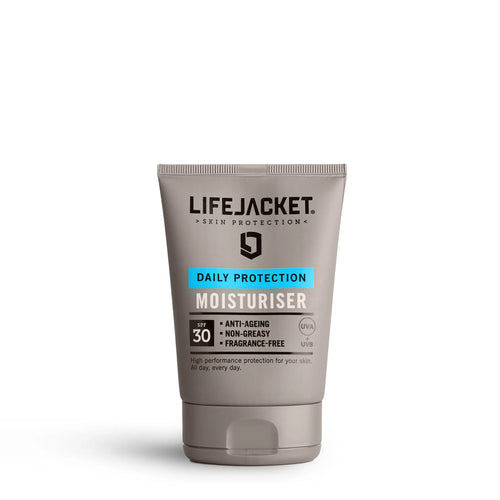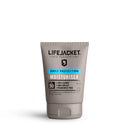UVA might not cause sunburn – but don’t be fooled.
You’ve probably heard of UV. It’s short for ultraviolet and it’s the name for the invisible radiation that comes from the sun. UV causes damage to skin. But did you know that UVA is a type of UV? And that it’s by far the most common type that reaches us?
Where UVB is responsible for sunburn, UVA is the one that creeps under the radar. You can’t see it. You don’t feel it. But it still causes damage. It’s the kind of damage that builds up over time. Silent. Invisible. Deep.
Here’s the big problem with UVA: it’s the long-wave form of UV, meaning it penetrates deeper into the skin – further than UVB. This affects cells in the dermis, the second layer of skin, where things like collagen, blood vessels and nerve endings live.

This deep-in-the-skin damage is linked to skin ageing, wrinkling, sun spots, and DNA changes that can lead to skin cancer. And unlike UVB, which varies with the seasons and gives you a warning (sunburn), UVA exposure doesn’t give you much to go on.
So when and where are you exposed to UVA?
UVA is present in daylight – including through glass and clouds – and makes up around 95% of the UV rays that reach your skin. The exact amount of UVA versus UVB depends on the time of day, time of year, and where in the world you are.
UVA drops significantly in winter, but it doesn’t disappear. It can still reach you through windows, light cloud and even thin clothing, particularly during daylight hours. You don’t need blazing sunshine to be exposed – but the levels are much lower than in summer.
What kind of damage does UVA do?
UVA’s biggest threat is how it builds up damage over time. It causes oxidative stress in your skin cells, triggering chain reactions that mess with cell function, DNA, and skin structure. It doesn’t cause sunburn in the same way UVB does, but it’s still harmful. It’s also linked to persistent pigment darkening – the kind of long-lasting tan that doesn’t mean your skin is healthy.
UV radiation overall is responsible for most visible signs of premature ageing. Studies show that UVB is much more potent at causing that structural damage, while UVA plays a slower, supporting role. Think of them as a team effort – both matter, just in different ways.
In short: it’s a tag team. You want to avoid both.
Does sunscreen protect against UVA?
Yes – if you choose the right one. Most good broad-spectrum sunscreens protect against both UVA and UVB rays. In the UK and EU, you can look for a UVA star rating or the ‘UVA in a circle’ symbol, which means it meets the minimum required protection relative to its SPF.

SPF measures protection against sunburn (erythema) – mostly driven by UVB, with a small UVA contribution – but it doesn’t quantify UVA protection. Choose broad-spectrum products and check for the EU “UVA in a circle” or a high UVA star rating so you’re covered for both.
Why is this important?
Because people often forget about UVA. It doesn’t burn. It doesn’t feel strong. It doesn’t leave a mark immediately. But it causes long-term damage, and that damage adds up – even on cloudy days, or when you’re sat indoors by a window.
It’s not about fear. It’s about awareness. It’s about being smart. And if you care about keeping your skin healthy for the long haul, UVA should absolutely be on your radar.
Conclusion
The role of our LifeJournal is to simplify and de-mystify one careful step at a time so that you’re not putting yourself and your family at risk. If you haven’t already read them, now's a good time to check out our other posts.
If we could leave you with one point from today’s post, it’s this: UV strength changes with the seasons, but UVA is always part of daylight. Building a daily SPF habit – like brushing your teeth – keeps your skin protected through all seasons and helps prevent long-term damage. It’s not about sunbathing or fear, just good daily practice for healthy skin.
For a bit of practical advice, put an SPF moisturiser next to your toothbrush. Every time you brush your teeth in the morning, just throw a teaspoon of moisturiser onto your head and neck. That way you're protected when you step outside. If you're in strong sun in the middle of summer, use a dedicated sunscreen on any exposed skin and re-apply every two hours. These simple steps will hopefully keep you skin-safe, younger-looking and healthy for years to come.
Thanks for taking the time to read this. It was an important one.








